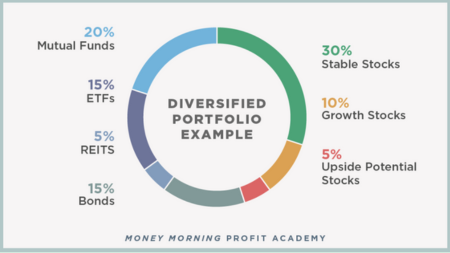No products in the cart.
Financial, Stock Market
The Critical Importance of Diversification in Stock Portfolios 2024
Introduction
In the dynamic and ever-evolving landscape of the Philippine stock market, investors are constantly searching for effective strategies to manage risk and optimize potential returns. One of the most time-tested and widely recognized methods for achieving this balance is diversification. By spreading investments across different asset classes, industries, and companies, investors can build a well-rounded portfolio that mitigates the risks associated with market fluctuations while capitalizing on various growth opportunities.
Diversification serves as a safeguard against the unpredictable nature of financial markets, ensuring that the negative performance of a single investment does not significantly impact the overall portfolio. In a market like the Philippines, where economic conditions, regulatory changes, and sectoral trends can influence stock prices, a diversified approach allows investors to navigate uncertainties with greater confidence.
This essay explores the importance of diversification in Philippine stock portfolios, highlighting its benefits, practical applications, and key considerations for investors looking to create a resilient and growth-oriented investment strategy. By understanding and implementing diversification effectively, investors can enhance their financial stability, improve long-term returns, and position themselves strategically in an ever-changing investment environment.

Advantages of Diversification
Diversification plays a critical role in safeguarding investments from the inherent uncertainties and fluctuations of the financial markets. This is particularly important in the Philippine context, where economic cycles, geopolitical factors, and regulatory changes can significantly impact stock prices. By allocating investments across various industries—such as technology, consumer goods, financial services, energy, and real estate—investors can minimize their exposure to sector-specific downturns. This strategic approach ensures that the underperformance of one sector does not disproportionately affect the overall portfolio, thereby maintaining stability even in turbulent market conditions.
Beyond risk reduction, diversification also enhances the potential for long-term capital appreciation. Different sectors of the economy experience varying cycles of growth and contraction, and a well-diversified portfolio can benefit from the rise of emerging industries while offsetting losses in others. This balanced approach helps investors achieve more consistent returns over time, making diversification particularly valuable for those with long-term financial goals, such as saving for retirement, preserving capital, or building generational wealth.
Additionally, diversification helps manage market volatility, as no single investment will dictate overall portfolio performance. The ability to hold a mix of high-growth and stable, income-generating assets ensures that an investor remains positioned for success, regardless of short-term fluctuations. Over time, a properly diversified portfolio has the potential to outperform concentrated portfolios that rely too heavily on individual stocks or sectors.
Practical Implementation
Effectively implementing diversification in a Philippine stock portfolio requires thorough research, strategic decision-making, and a clear understanding of market trends. Investors should analyze different industries with growth potential while considering macroeconomic indicators such as inflation rates, government policies, and consumer behavior. Paying attention to regulatory frameworks and sector-specific developments allows investors to make informed decisions about where to allocate their capital.
Moreover, diversification should extend beyond sector allocation to include regional exposure. While the Philippine stock market offers numerous investment opportunities, investors can further enhance their portfolios by considering international stocks, exchange-traded funds (ETFs), or mutual funds that provide exposure to global markets. Expanding beyond local investments helps mitigate risks associated with domestic economic downturns and allows investors to capitalize on global growth trends.
Investors should also consider using a mix of investment instruments to achieve diversification. In addition to individual stocks, incorporating assets such as mutual funds, ETFs, index funds, and fixed-income securities can create a more balanced portfolio. Each investment vehicle carries unique benefits and risk factors, enabling investors to tailor their portfolios according to their risk tolerance, time horizon, and financial objectives.
Furthermore, periodic portfolio reviews and rebalancing are essential to maintaining diversification and optimizing long-term investment performance. As market conditions fluctuate, certain assets may become overrepresented in a portfolio due to rapid price appreciation, while others may decline in value or underperform. Without regular adjustments, this imbalance can lead to increased exposure to certain sectors, potentially increasing risk and limiting growth opportunities.
Example of Portfolio Rebalancing in Action
Consider an investor who originally allocates their ₱500,000 investment into different sectors:
40% in blue-chip stocks (e.g., SM Investments, Ayala Corporation)
30% in growth stocks (e.g., Converge ICT, Monde Nissin)
20% in fixed-income assets (e.g., government bonds, corporate bonds)
10% in international ETFs (e.g., S&P 500 index fund)
After one year, the stock market experiences a boom in tech and consumer stocks, causing the growth stocks in the portfolio to surge in value. Now, the allocation shifts to:
50% in growth stocks
30% in blue-chip stocks
15% in fixed-income assets
5% in international ETFs
While the investor benefited from stock market gains, the portfolio has become unbalanced, increasing exposure to a single high-growth sector. To mitigate risk, the investor should rebalance by selling a portion of the growth stocks and reinvesting in blue-chip stocks, bonds, or international ETFs to restore the original allocation. This adjustment helps preserve stability while still allowing for growth.

Difficulties and Considerations in Diversification
While diversification offers numerous benefits, it also comes with its own set of challenges that investors must carefully navigate. One of the most common pitfalls is over-diversification, where an investor spreads their capital across too many assets, diluting potential gains. While holding multiple investments helps reduce risk, excessively broadening a portfolio can result in lower returns, as gains from well-performing stocks may be offset by the underperformance of weaker assets. For instance, an investor who holds shares in 50 different companies may find that their best-performing stocks do not significantly impact their overall returns due to the sheer number of holdings.
To strike the right balance, investors should focus on a strategically diversified portfolio that includes a mix of industries and asset classes without overcomplicating their investments. A well-balanced portfolio should ideally contain stocks from key sectors such as banking, technology, consumer goods, and real estate, while avoiding excessive exposure to a single industry. For example, a Filipino investor might hold shares in SM Investments Corporation (retail & property), Ayala Corporation (real estate & finance), Jollibee Foods Corporation (consumer goods), and ICTSI (logistics & infrastructure) to ensure a healthy mix of industries while avoiding unnecessary duplication.
The Importance of Portfolio Rebalancing
Another critical aspect of diversification is portfolio rebalancing—the process of adjusting asset allocations to maintain the desired level of diversification over time. As market conditions fluctuate, certain stocks or sectors may experience significant growth, while others underperform. Without periodic rebalancing, a portfolio can become too concentrated in a few outperforming sectors, increasing risk exposure.
For example, suppose an investor initially allocates 25% of their portfolio to financial stocks, 25% to consumer goods, 25% to technology, and 25% to real estate. Over time, if technology stocks experience rapid growth, they might comprise 40% of the portfolio, reducing exposure to other sectors. While this may seem beneficial in the short term, it also increases the risk of losses if the tech sector faces a downturn. Rebalancing would involve selling a portion of tech stocks and reallocating the proceeds to underweighted sectors, ensuring a well-diversified portfolio aligned with the investor’s risk tolerance and long-term objectives.
Diversification as a Long-Term Strategy
Ultimately, diversification is a fundamental principle in managing a successful Philippine stock portfolio, providing a safeguard against market volatility while optimizing long-term returns. By investing in a mix of industries, businesses, and asset classes, investors can take advantage of multiple growth opportunities while minimizing exposure to sector-specific downturns. However, effective diversification requires more than just spreading investments—it demands strategic asset allocation, continuous monitoring, and disciplined portfolio management.
By adopting a proactive approach to diversification, Filipino investors can confidently navigate the complexities of the stock market, ensuring financial resilience and sustainable wealth growth over time.
Conclusion
Diversification is a crucial investment strategy that helps reduce risk, maximize returns, and create a more stable financial portfolio. In the context of the Philippine stock market, where economic shifts, industry trends, and geopolitical factors can significantly impact stock performance, having a well-diversified portfolio is essential for long-term success. By investing across various industries, asset classes, and even international markets, investors can better manage risks while ensuring consistent growth opportunities.
However, diversification should be approached with a well-thought-out strategy rather than simply spreading investments randomly. Over-diversification can dilute potential gains, while insufficient diversification exposes investors to significant risks if one sector or asset class underperforms. Achieving the right balance requires careful selection of stocks, periodic portfolio reviews, and necessary adjustments to maintain optimal asset allocation.
Furthermore, portfolio rebalancing plays a vital role in sustaining diversification. As market conditions change, an investor’s portfolio can become skewed toward certain sectors, increasing exposure to potential losses. By regularly assessing holdings and making adjustments based on market trends and personal financial goals, investors can ensure that their portfolios remain aligned with their risk tolerance and investment objectives.
In summary, successful diversification requires a combination of strategic planning, informed decision-making, and continuous portfolio monitoring. Filipino investors who embrace diversification as a core principle can better withstand market fluctuations and achieve long-term financial growth and stability. Whether investing in blue-chip stocks, emerging market opportunities, or international assets, a well-balanced portfolio is the key to sustainable wealth-building in an ever-changing investment landscape.
If you like reading this, please like and share my page, DIARYNIGRCIA PAGE.
Questions or suggestions, send them to diarynigracia@gmail.com
You may also follow my Instagram account featuring microliterature, visit DIARYNIGRACIA INSTAGRAM.
READ MORE RELATED BLOGS!
READ MORE AND SHARE!
TSOK Chronicles: Unleashing Passion, Dedication, and Excellence in 2024
2023 Your Practical Wedding Guide
Investments and Finance Ultimate Guide
If you like this article please share and love my page DIARYNIGRACIA PAGE Questions, suggestions send me at diarynigracia @ gmail (dot) com
You may also follow my Instagram account featuring microliterature #microlit. For more of my artworks, visit DIARYNIGRACIA INSTAGRAM
DISCLAIMER
Please note:
The information provided in this financial analysis blog entitled "The Critical Importance of Diversification in Stock Portfolios 2024" is for informational purposes only based on my study and research. Furthermore, personal research may also be conducted as information presented my change over time. While I strive to provide accurate and timely information, I make no guarantees regarding the reliability, accuracy, and strongly relies on time and availability of the economy at time of writing. Investments carry inherent risks, and it is essential to conduct your own research or consult with a licensed financial advisor before making any investment decisions. The views, opinions, and valued research and analysis presented are those of the author and may not reflect the official policy or position of any company or financial institution.
📷 MEDIA CONTENT DISCLAIMER All rights and credits reserved to its respective owner(s). If you are the main copyright owner rather than the one mentioned here on this content, contact us to claim credit or remove content.


Peace and love to you.